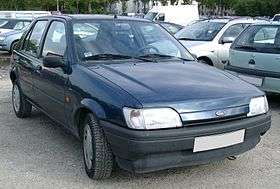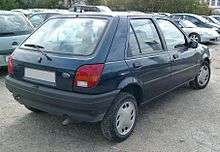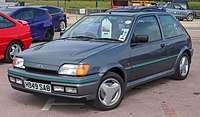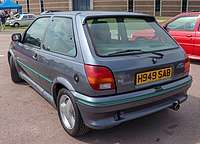Ford Fiesta (third generation)
The Ford Fiesta Mk3 was the third generation of the Ford Fiesta supermini built by Ford Europe. Originally introduced in 1989, the Mk3 represented the biggest change to the Fiesta since the original car was introduced in 1976. In addition to the 3-door hatchback and panel van versions that had formed the Fiesta range, a 5-door hatchback was also added. The Fiesta Mk3 was replaced by the Fiesta Mk4 in 1995, but remained on sale until early 1997. The Mk4 was a major restyle of the Mk3, but had the same chassis.
| Ford Fiesta Mk3 | |
|---|---|
 | |
| Overview | |
| Manufacturer | Ford Europe |
| Production | February 1989–February 1997 |
| Assembly |
|
| Body and chassis | |
| Class | Supermini (B) |
| Body style | 3/5-door hatchback 3-door panel van 3-door high cube panel van |
| Platform | Ford B platform |
| Related | Ford Ka Ford Courier |
| Powertrain | |
| Engine | 999 cc HCS I4 1,118 cc HCS I4 1,297 cc HCS I4 1,392 cc CVH I4 1,392 cc CVH-PTE I4 1,596 cc CVH I4 1,596 cc CVH Turbo I4 1,598 cc Zetec I4 1,796 cc Zetec I4 1,753 cc LT Diesel I4 |
| Transmission | 4-speed IB4 manual 5-speed IB5 manual CVT automatic |
| Dimensions | |
| Wheelbase | 2,446 mm (96.3 in) |
| Length | 3,743 mm (147.4 in) |
| Width | 1,606 mm (63.2 in) |
| Height | 1,321 mm (52.0 in) |
| Chronology | |
| Predecessor | Ford Fiesta (second generation) |
| Successor | Ford Fiesta (fourth generation) |
The Fiesta Mk3 also spawned a high-cube panel van version in 1991, the Courier, and also shared its platform with the Ka of 1996, which was derived from the Fiesta Mk4.
History
The third generation Fiesta, codenamed BE-13 was unveiled at the end of 1988 and officially went on sale in February of the following year with UK sales commencing in April. The car was based on a new platform ditching the old car's rear beam axle for a semi-independent torsion beam arrangement and looked radically different, addressing the principal weakness of the previous generation – the lack of a 5-door derivative, something that was by then available in its major rivals such as the Fiat Uno, Peugeot 205 and Opel Corsa/Vauxhall Nova. The other main change was to the running gear – the improved HCS (High Compression Swirl) version of the Kent/Valencia powerplant. The CVH units from the second generation were carried over largely unmodified. The LT diesel engine was enlarged to a 1.8L capacity.
This model had the longest production life of any Fiesta to date, achieved the highest yearly sales of any Fiesta in the early 1990s – achieving a sales volume of 1 million units inside the first two years of production. A Fiesta-derived van, the Courier, was launched in 1991.
In the British market, Fuel injected engines only became available in 1991. They had been sold in countries with more stringent emissions controls since the introduction.[1] In 1992 a number of prototype cars were produced by Ford fitted with direct injection two stroke engines produced by the Orbital Engine Corporation of Australia, with full-scale production anticipated by Ford in "two to three years time".[2] The cars were tested extensively in the UK, but ultimately it was decided not to go ahead with production versions. Major changes were introduced to the range in 1993; major structural improvements were made to improve safety, as well as a new immobiliser being fitted to petrol models. Revised door mirrors were also fitted, as were a line-up of fresh wheel trim designs.
As for sports models, the XR2i was launched in 1989[3] with an eight-valve CVH engine with 104 PS (76 kW). This was then replaced by a Zetec 16 valve version in 1992, which also saw the RS Turbo being supplanted by the RS1800 as the CVH engine was being phased out. The RS1800 shared its engine with the 130 PS (96 kW; 130 bhp) version of the then-current Escort XR3i and had a top speed of 125 mph (201 km/h). The XR2i name was dropped in early 1994, and the insurance-friendly "Si" badge appeared in its place on a slightly less sporty-looking model with either the 1.4 L CVH-PTE (a development of the CVH) or the 1.6 L Zetec engine.
From 1995 the vehicle was built and sold at the same time as the new Mark 4. To distinguish the car, trim levels were revised, and it was marketed as the "Fiesta Classic", with a small range consisting of Classic, Classic Quartz, and Classic Cabaret models, and a ‘Special Edition’ Frascati model. This version continued until production finally ceased in early 1997.
Commercial models
As with the Mark 2, this generation was available as a panelled van in many markets. This range offered a limited number of engines. From late September 1990 the van was also available with the new catalyzed central injection (CFi) 1.4-liter petrol engine.[4]
A box van version of the Fiesta appeared in the summer of 1991, but was sold as the Ford Courier.
RS Turbo
The Fiesta RS Turbo was a performance model of the Fiesta Mk3. It was introduced in April 1990 and production continued until 1992.[5]
Based on the XR2i, introduced a year earlier, it was visually similar. The main differences were 14" alloy wheels (an inch larger and of a different design than those fitted to the XR2i) with 185/55 VR14 Pirelli P600 tyres, green rather than blue stripe mouldings, colour-coded rear spoiler and door pillars, opening rear quarter windows, green tinted glass and RS bonnet louvres. Anti-lock brakes and a "Quickclear" heated front windscreen were options at extra cost.
Inside the car the differences included Recaro seats trimmed in "Ascot In Raven" material and a grey leather trimmed gear knob and a three-spoke steering wheel (as opposed to the two-spoke used in the XR2i), which also had the RS Turbo logo embossed on the centre cap.
The RS Turbo's CVH engine retained the same 1597cc capacity as the XR2i, but had a lower compression ratio of 8:1. The Garrett T2 turbocharger supplied 8 psi (55 kPa) of boost and was chosen as space between the engine and radiator prevented the use of the larger T3 from the Escort RS Turbo. As with the Escort, an air-to-air intercooler was fitted, although this was slightly larger on the Fiesta. The quoted power output was 133ps at 5500rpm, with 183 nm of torque at 2400rpm which gave the car a top speed of 133 mph and a 0-60 of 7.9 seconds.
The car was not generally well received with reviews citing poor handling and uncommunicative steering as its weak points. The spiralling insurance premiums brought on by the British joyriding epidemic of the early 1990s did not help either, with the car being a popular target for thieves.
RS1800
The Fiesta RS1800 was introduced as the replacement for the RS Turbo in 1992. The turbocharged 1.6 L CVH engine from the RS Turbo was replaced by a 1.8 L version of the Zetec engine, and had a similar claimed maximum power output of 130 PS (96 kW; 130 bhp),
Specifications
_(cropped).jpg) Fiesta Mk3 5-door front (pre-facelift)
Fiesta Mk3 5-door front (pre-facelift)- Fiesta Mk3 3-door (pre-facelift)
 Fiesta Mk3 5-door (post-facelift)
Fiesta Mk3 5-door (post-facelift) Fiesta RS Turbo
Fiesta RS Turbo Fiesta RS Turbo
Fiesta RS Turbo.jpg) Fiesta Mk3 van
Fiesta Mk3 van- Interior
References
- Büschi, Hans-Ulrich, ed. (9 March 1989). Automobil Revue 1989 (in German and French). 84. Berne, Switzerland: Hallwag AG. p. 285. ISBN 978-3-444-00482-7.
- "The phut-phut Fiesta". Autocar and Motor (8 July 1992).
- "Still going strong, Ford's youthful spirited Fiesta is celebrating its 30th birthday". Media.Ford.com. 25 August 2006.
- Weatherley, Brian, ed. (1990-09-20). "NEC Show Trends: Light Vehicles". Commercial Motor. 172 (4387): 91. ISSN 0010-3063.
- AdrianFRST (19 April 2001). "Performance Fiesta Mk3 History". fiestaturbo.com. Retrieved 13 February 2015.